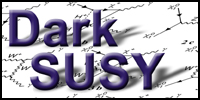|
|

Documentation
Overview
The most complete description of the physics going into DarkSUSY is
T. Bringmann, J. Edsjö, P. Gondolo, P. Ullio and L. Bergström,
JCAP 1807 (2018) 033 [arXiv:1802.03399]
and
P. Gondolo, J. Edsjö, P. Ullio, L. Bergström, M. Schelke
and E.A. Baltz,
JCAP 07 (2004) 008 [astro-ph/0406204],
as well as references therein. Please refer to this if you use DarkSUSY. Updates after version 6.1 are described here (until version 6.3).
There is an (incomplete) manual in pdf format, as well as a long version with routine headers: Manual-long.pdf. After 'make manual', you can also
find these files in the /docs directory of your DarkSUSY installation.
A very good way of getting
started and exploring the various features of DarkSUSY
is typically to have a look at the example programs located in the /examples directory
of every download. Some example applications are further illustrated here.
Main concepts
As illustrated in the figure below, every main program (provided by the user)
has to be linked to the DarkSUSY core library (containing only fully model-independent routines) and one of the implemented particle physics modules.

The core library communicates with the active particle physics module via a small
set of interface functions (these functions, about a dozen in the
present release, also contain the keyword 'interface' in the function header).
Another concept of practical importance is that of replaceable
functions: the modularity of the code allows to 'replace' most
DarkSUSY functions with a user-defined version, which then is used fully consistently
in the rest of the code, without recompiling the DarkSUSY libraries or
changing anything in the installation
directory. In particular, this can be done for all interface functions.
(One conrete example for the application of this conecpt is
provided in examples/aux/oh2_generic_wimp.f and its two different make targets,
'make oh2_generic_wimp' and 'make oh2_generic_wimp_threshold')
Typical usage
There are many ways of using DarkSUSY, but in the following we briefly outline
the recommended way for non-expert users. This is the least error-prone way as
it ensures that you keep your own code (and modifications) separate and that you
never modify the officially released version of
the code. Following these steps also ensures that you always link to the correct
version of the DarkSUSY libraries, and use the same compiler settings as
automatically determined during the installation process.
1. After installing DarkSUSY, choose the example
program in /examples/aux/ that comes closest to what you plan to do.
Copy the respective EXAMPLE_PROGRAM.f, along with the makefile in that directory
into a separate, local directory my_DS_mains/ that lies outside the
DarkSUSY installation directory.
2. In my_DS_mains/, edit the makefile to a) remove all target blocks that refer
to programs you have not copied and then b) change every occurence of
'EXAMPLE_PROGRAM' with the name that you want to give your main program.
Make sure to change the filename of EXAMPLE_PROGRAM.f correspondingly.
[2b. If you want to 'change' any of the routines provided by DarkSUSY, follow the
example of replaceable functions for oh2_generic_wimp.f, as indicated above.]
3. Edit your new example program as desired, then simply type 'make' to compile.
DONE :)
|